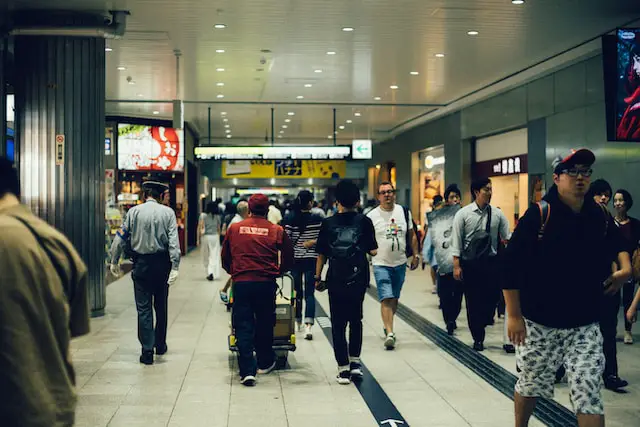Welcome to our definitive guide on navigating airports in Japan. As one of the most sought-after destinations in the world, and bearing the reputation of having intricate systems, exploring Japan begins from the moment you step off your flight.
In essence, Japanese airports showcase a fascinating mix of modern design, innovative technology, and the country’s unique character. Whether it’s Tokyo’s bustling Narita or Haneda airports, or the beautifully spray-draped Kansai airport, there’s a uniqueness that’s seemingly omnipresent. Each airport is a complex, self-contained city vital for those planning travel to Japan.
These architectural marvels cater to millions of passengers each year and are equipped with an array of services, from automated systems to multilingual assistance that helps international visitors navigate efficiently. This guide aims to unravel some vital elements that make journeying through Japanese airports an experience worth remembering.
Understanding Japanese Airport Terminals
When planning your travel to Japan, getting familiar with the layout of its major airports is crucial to ensuring smooth navigation on arrival. Three of the most prominent airports you may find yourself landing in are Narita, Haneda, and Kansai.
Narita International Airport is one of the busiest airports in Asia. It consists of three terminals, namely Terminal 1, Terminal 2, and Terminal 3. Terminal 1 is for international airlines mainly from North America, and Europe. Terminal 2 is primarily for Japan Airlines’ operations. Terminal 3 is devoted to low-cost carriers like Jetstar Japan.
Haneda Airport, positioned closer to Tokyo, consists of three terminals. Terminal 1 and Terminal 2 are domestic terminals serving Japan’s major airlines – Japan Airlines and All Nippon Airways. While the International Terminal primarily services overseas flights.
Kansai International Airport, located in Osaka, has only two terminals. Terminal 1 is a multistory structure housing both domestic and international flights, while Terminal 2 is a simpler structure catering primarily to low-cost carriers.
Understanding the structure, differences, and services offered in these terminals is key to navigating airports in Japan. Websites and apps often offer Haneda airport guides, detailed maps of Narita airport terminals, and Kansai airport layout visuals to help acclimatize travelers before arrival. So, when you travel to Japan, ensure you take some time to familiarize yourself with these layouts.
Your journey through the fascinating world of Japanese airports will become much easier once you’ve understood the terminal layouts!
Japanese Signage and Wayfinding: Making Sense of It All
For anyone traveling to the land of the rising sun, understanding Japanese airport signage can feel a bit daunting, but fear not! Navigating airports in Japan can be less stressful once you familiarize yourself with how signage and wayfinding system works.
In most Japanese airports, bilingual signs are common, ensuring that non-Japanese speaking travelers can navigate the airports without much hassle. You’ll find that major instructions, warnings, and informational signs are displayed both in Japanese and English. This abundance of English in Japanese airports can be a lifesaver for international travelers. Moreover, pictograms are widely used, supplementing written instructions with universal symbols to convey important information.
A unique feature of the Japanese sign system is the color-coded signs. Typically, blue signifies directions, yellow for warnings and green for emergency exits. Paying attention to these colors can help you navigate through Japanese airports more smoothly. Most importantly, remember that these colors are consistent across all airports in Japan.
If you’re concerned about finding your way from the moment you step off the plane, worry not, as most Japanese airports have Information Desks staffed by English-speaking staff. They can help you better understand the wayfinding system, should you encounter any difficulties.
Understanding signs and wayfindings in Japanese airports might at first be a little overwhelming, but with these tips in mind, you’re sure to navigate your way efficiently, beginning your Japan travel adventure with confidence.
Airport Facilities and Services
When you’re traveling to Japan, you will be met with a plethora of impressive amenities, designed for your convenience and comfort, at all major Japanese airports. Being the heart of hospitality, Japanese airports thrive by offering boundless facilities and services.
Navigating a foreign airport might seem daunting, but rest assured, Japanese airport facilities are designed with ease of use in mind. Prior to traveling, it’s helpful to know what to expect.
If you’ve just landed and need to sort out your yen, there are numerous currency exchange counters in Japanese airports; some are even open 24/7. For those who prefer the digital realm, free WiFi in Japanese airports is readily available, providing you fast and reliable connectivity wherever you are.
Travel fatigue can make charging your electronics a priority, thus, it’s handy to note the abundance of charging stations throughout terminals. Worried about your luggage? Japanese airports have you covered with their range of luggage services – from lockers to delivery services, they ensure your travel remains hassle-free.
Whether you’re catching a quick nap, need a hot shower, or want to grab a meal, you’ll find dedicated facilities take care of these needs. Most airports in Japan also feature fabulous shopping and dining options.
So, whether you’re embarking on an adventure or just passing through, anticipate world-class services on par with a five-star hotel when you visit any airport in the Land of the Rising Sun.
Japanese Customs Process
If you’re visiting Japan for the first time, navigating through Japanese airports customs may seem somewhat daunting. But don’t fret – this guide is here to help smooth the way during your travels.
Upon landing, the first area you typically encounter is immigration. Fill out the Disembarkation Card for Foreigners you receive during your flight prior to meeting immigration officers. You’ll be asked routine questions about your stay. A photograph and fingerprints are taken as part of their high-tech security protocols. This process is quick, efficient, and very straightforward.
Next comes the customs section where your luggage will go through a security screening. Japan has stringent rules on what can and cannot be brought into the country. It’s important to declare any questionable items to avoid any penalties. You will fill out a Customs Declaration form. If you have nothing to declare, follow the green channel. If you do have items to declare, take the red channel.
Understanding the Japanese customs process thoroughly helps ease the potential stress of this leg of travel. It’s advised to check the Japan Customs website before your trip to familiarize yourself with restricted and prohibited items. By being well prepared, you will ensure a smooth entry into Japan, setting a positive tone for your entire trip.
So pack wisely, familiarize yourself with the process, and let the excitement of your imminent exploration take hold! Welcome to the Land of the Rising Sun.
Japanese Airport Transport
Traveling to Japan is an exceptional experience, and understanding the airport transport options is essential for a hassle-free journey. Japanese airports offer a diverse set of transportation choices, designed to cater to every traveler’s preferences and needs.
Narita, one of the most recognized international airports in Japan, has readily available “transport from Narita” offering both comfort and convenience. Railways, including the Narita Express and Keisei Skyliner, provide a fast and reliable connection from Narita to Tokyo and other major cities.
Moving on to “bus services in Japanese airports,” the Airport Limousine Bus service is widely available. This comfortable and budget-friendly service links cities with major airports, like Haneda and Narita. It’s an excellent option if you’re carrying heavy luggage or aiming for a direct ride to your hotel.
Journeying through “Japanese airport taxis” warrants a little more expense, however, the personalized service and direct route might just be worth it, particularly after a long flight. Taxis can be found lined up outside arrivals, ready to whisk you away to your final destination.
For the more adventurous, car rental services are also available at Japanese airports. This is an option worth considering if you’re planning to explore off the beaten path during your visit to Japan.
In summary, whether by train, bus, taxi, or car rental, Japan’s well-coordinated airport transport systems ensure that setting off from the airport to start your Japan exploration is a breeze.
Practical Tips and Tricks for a Smooth Transit
Welcome to the world of Japanese airports where everything runs like clockwork. But to ensure a fuss-free experience, here are some nuggets of wisdom to help ace your navigation.
Our first suggestion includes using technology to your advantage. Several handy applications can make your airport experience more manageable. Be sure to download essential Japan travel advice apps like Navitime Japan Travel or Google Translate. This will help you with everything from understanding intricate Japanese airport guide maps to interpreting local language signs.
Next, let’s talk about packing. In our experience, having a well-packed carry-on bag can make or break your transit experience. Pay special attention to packing your passports, flight documents, essential toiletries, spare clothes, and some snacks. It’s a small step, but it will have significant benefits when navigating airports in Japan.
Finally, we can’t stress enough the importance of early check-in. Whether it’s Haneda, Narita, or Kansai, Japanese airports are huge! Not only will early check-in save you time, but it will also allow for a more relaxed journey to your gate. Who knows, you might even have extra time to explore various Japanese airport facilities or indulge in a quick sushi meal.
Remember, a little prudence goes a long way. With these tips for smooth transit in Japanese airports, your journey is sure to be an enjoyable part of your Japan adventure.
Conclusion
Navigating Japanese airports may seem daunting at first sight, but with a bit of understanding and preparation, it can become a breeze. Throughout this guide, we’ve shed light on the various complexities and peculiarities of airports in Japan, from understanding airport terminals like Narita, Haneda, and Kansai to making sense of signage in English and pictograms.
Undoubtedly, you’ll appreciate the plethora of amenities in the form of free WiFi, numerous charging stations, convenient currency exchange points, and many other Japanese airport facilities. Remember, part of ‘Japan travel’ is immersing yourself in the unique customs process, so don’t forget to brush up on what’s expected when you’re ‘visiting Japan’.
Many viable transport options are at your disposal once you exit the airport, such as convenient trains, friendly bus services, and plenty of taxis. We’ve endeavored to give you the clearest possible guide to these services, with ‘transport from Narita’ and ‘Japanese airport taxis’ being particularly comprehensive.
Moreover, with a handful of our practical tips and tricks for smooth transit, such as downloading essential apps and observing early check-in, your time in Japanese airports is likely to be enjoyable. Ultimately, our aim is to prepare you to navigate airports in Japan with ease, and more importantly, to ensure your journey makes a pleasant start to your broader experience of ‘exploring Japan’.
Get ready for your adventure and enjoy everything that ‘Japan travel’ has to offer, starting from the moment you step off the plane. Safe travels, and enjoy your journey through Japanese airport navigation and beyond!




